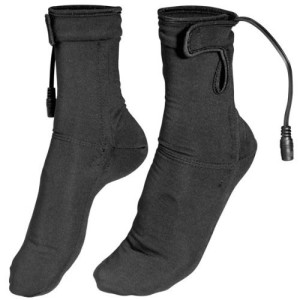 Electronic heating socks are used by many people for a variety of different reasons ranging from working in cold conditions, hunting, and even just having cold feet around the house due to poor circulation, arthritis, and a number of other different variables that cause discomfort due to cold feet. A lot of people don’t like them, because of how they work. But exactly how do they work?
Electronic heating socks are used by many people for a variety of different reasons ranging from working in cold conditions, hunting, and even just having cold feet around the house due to poor circulation, arthritis, and a number of other different variables that cause discomfort due to cold feet. A lot of people don’t like them, because of how they work. But exactly how do they work?
Basically, the electronic sock works by having a D-Cell battery, or a higher grade rechargeable battery, run electrical currents through wire, that are fashioned around the area that are around where the bottom of your foot would be placed, if worn properly. When turned on and the battery connected, electricity warms the wire, in turn, warming the foot and toes. A lot of models now come with an AC adapter that plugs into an ordinary wall socket, instead of running off of bulky batteries that need to be recharged over time.
The materials that are used in these socks vary from product to product, however, most models feature the same type of metal found in electric blankets, which is a resistive wire that generates heat when electricity is running through it. Generally, they are made with either wool, or a pure cotton material, depending on the make that is purchased. It is highly recommended that with whatever conditions you’re using heated socks in, that you wear a thin sock, so the heating elements have no direct contact with your feet, because that could cause burns over extended periods of use.
There are several models to choose from, ranging from a thick wool for long hunting trips or work days in the cold, to a thin cotton, that is meant to fit inside smaller, athletic shoes for hiking, mountain biking, or other sports. Like I stated earlier, there are also models out there that are a medium sized thickness that are made for chronic cold feet due to a number of different issues, which are usually used around the house.
As far as the battery goes, it really varies, as technology is always advancing, and needs are always changing due to the market. Some less expensive models feature a D-Cell battery, while more exquisite models feature either an AC adapter, or a rechargeable battery. The more expensive makes also usually feature a control box that can be used to control the heat of the socks. The battery is mainly fashioned on the inside of the calf in a hideaway, so it doesn’t cause irritation, or weigh the socks down. However, with the less expensive models are said to have cheaper elastics, so the battery weighs down on the calf, making the sock ride down.
Long story short, whether you’re ice fishing in Alaska, working a blizzard in the mountains, hunting for hours in below freezing temperatures, or have any issues with feet that just won’t stay warm, these relatively new electronically heated socks could potentially save your feet from uncomfortable conditions, or even save you from losing toes, or getting blisters from cold conditions.
